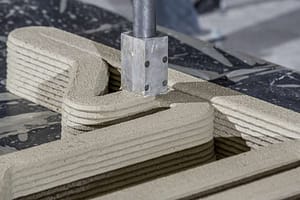Table of Content
Concrete Definition:
Concrete is a robust construction material with a precise composition comprising cement, water, aggregates like sand or gravel, and sometimes additives for specific properties. This amalgamation undergoes a process that transforms it from a malleable mixture to a solid, durable substance. The reaction between cement and water leads to hydration, which strengthens the material over time.
What sets concrete apart is its adaptability to diverse applications in the construction domain. It is meticulously formulated to achieve desired characteristics like compressive strength, workability, and durability. Once it cures, concrete becomes a foundation for skyscrapers, a framework for bridges, and the surface of roadways. Its resilience under compression makes it ideal for supporting heavy loads and enduring various environmental conditions.
In essence, concrete embodies the synergy of science and engineering, providing the building blocks for modern infrastructure and architectural marvels. From towering structures to intricate pavements, concrete stands as a testament to humanity’s ability to harness natural resources and shape them into a cornerstone of the built environment.
Here are some key points about concrete:
1. Components:
-
- Cement: The primary binding agent that holds the mixture together. Portland cement is the most common type used in concrete.
-
- Aggregates: These provide bulk to the mixture and contribute to the concrete’s strength. They can be coarse (such as gravel) or fine (such as sand).
-
- Water: Required for the chemical reaction that hardens the concrete.
-
- Admixtures: These are added to modify certain properties of the concrete, such as setting time, workability, and durability.
2. Production Process:
-
- The process begins by mixing the cement, aggregates, and water to form a paste. The paste coats the aggregates and binds them together.
-
- The mixture is then placed in molds or formwork to shape it according to the desired structure.
-
- After placing, the concrete undergoes a curing process to ensure proper hydration and strength development.
3. Types of Concrete:
-
- Plain Concrete: Consists of the basic ingredients and is used in applications where appearance is not a primary concern.
-
- Reinforced Concrete: Contains steel reinforcement bars or mesh to enhance its tensile strength. This type is commonly used in structural elements like beams, columns, and slabs.
-
- Prestressed Concrete: Incorporates tensioned steel cables or tendons to induce compressive stresses, increasing its strength for specific applications.
-
- Stamped Concrete: Designed to mimic the appearance of materials like brick, stone, or tile by using textured patterns during pouring.
-
- High-Strength Concrete: Engineered to have greater compressive strength, often used in high-rise buildings and structures requiring heavy loads.
-
- Self-Consolidating Concrete: Highly flowable and does not require mechanical vibration to compact. It is used in areas with complex shapes or dense reinforcement.
4. Applications:
-
- Concrete is used in a wide range of construction projects, including buildings, bridges, roads, dams, tunnels, pavements, and more.
-
- It’s also used for decorative purposes, like countertops, flooring, and architectural features.
5. Sustainability:
-
- The production of cement, a key component of concrete, contributes to carbon dioxide emissions. Efforts are being made to develop more environmentally friendly alternatives.
6. Maintenance and Durability:
-
- Concrete structures can last for decades if properly designed, constructed, and maintained. However, they may require periodic maintenance to address cracking, spalling, and other forms of deterioration.
Concrete Definition: Concrete is a fundamental material in modern construction due to its versatility, strength, and ability to adapt to various applications and design requirements.





